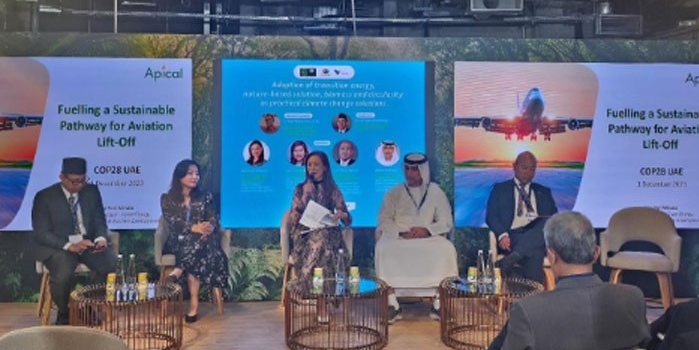Woodfibre LNG Strengthens Community Building in Squamish
Squamish, a community in the Canadian province of British Columbia, is located at the north end of Howe Sound on the Sea to Sky Highway. Home to stunning climbing routes...

Latest updates on what's happening in RGE Group

This article is an adaptation of “Sustainable Aviation Fuel Offers Hope, but Decarbonising Air Travel Needs Everyone Onboard”, published in The Jakarta Post. Changes include rewriting some of the passages and adding original materials.
The advent of sustainable aviation fuel (SAF), a liquid fuel used in commercial aviation that significantly reduces carbon dioxide (CO2) emissions, is poised to revolutionise the aviation sector and pave the way for a more environmentally friendly future, according to industry players.
BIS Research, a leading provider of market intelligence on disruptive technologies, forecasts a remarkable growth trajectory for SAF, projecting its valuation to soar to US$131.12 billion by 2033, up from $1.29 billion in 2023.
SAF emerged as a key topic of discussion at the United Nations Climate Change Conference (COP28), held in Expo City Dubai, the United Arab Emirates .
Speaking at COP28, Aika Yuri Winata, General Manager of Green Energy, Biofuel Feedstock and Business Development at Apical, a leading vegetable oil processor with an expanding global footprint, highlighted SAF’s transformative potential in propelling the aviation industry to a net-zero future.
Currently, the global aviation sector faces significant challenges in decarbonisation, accounting for approximately 3 percent of CO2 emissions in 2019. To address this pressing issue, the International Air Transport Association (IATA) set a net-zero target for airlines to achieve by 2050 during its 77th Annual General Meeting held in Boston, the United States, on 4 Oct 2021.
SAF, widely regarded as the most promising and viable alternative to conventional jet fuel, holds the potential to significantly reduce CO2 emissions by up to 90 percent, offering a beacon of hope for a cleaner aviation future.
Overcoming adoption hurdles: Southeast Asia – a potential powerhouse for SAF production
Despite its promise, SAF adoption remains limited, with its current share in the aviation fuel mix standing at less than 0.1 percent. Industry actors face formidable challenges in scaling up SAF production due to limited supply and feedstock restrictions, leading to high production costs when compared with conventional fossil-based jet fuel. The SAF supply chain also grapples with a “chicken-and-egg” dilemma where the interdependence of supply and demand exacerbates the issue. Notably, costs could decrease with increased production, thanks to economies of scale.
However, there remains a lack of robust demand signal from fuel providers, and the lacklustre demand stems from the low consumer interest caused by the elevated price premium associated with SAF.
To accelerate SAF adoption and decarbonise air travel, Aika proposed leveraging the strengths of the ASEAN region, which possesses immense potential for scaling up SAF production globally.
She noted that six ASEAN countries collectively had the potential to supply over 10.4 million tonnes of waste and residue oil annually for SAF production, sourced from materials such as used cooking oil (UCO), palm oil mill effluent (POME), empty fruit bunch (EFB) oil, palm fatty acid distillate (PFAD) and crude palm oil closed pone (CPO with MC).
Enablers for sustainable aviation
In parallel with a production ramp-up, Aika emphasised the need for policy interventions, sustainable financing and stronger demand signals to drive SAF adoption.
Industry actors anticipate that governments worldwide will mandate SAF usage and establish incentive schemes. Policies should align with international standards and expectations, incorporating traceability principles, accountability and governance components.
Finance is the other powerful tool to incentivise producers and airline operators to pursue SAF, Aika encouraged the introduction of sustainability-linked loans to back decarbonisation efforts.
These present an opportunity for Asia to create a coherent and harmonised framework that would provide certainty for investors on the investment horizons, and offer operators a comprehensive grasp of regulations across the region.
Decarbonising air travel requires collective effort, and it is therefore imperative that everyone is “on board”. Demand-side incentives are therefore also crucial – airlines, air cargo carriers and consumers need to send stronger signals to encourage production expansion to achieve economies of scale and eventually bring the costs down, approaching parity with conventional jet fuel.
Aika also underscored the importance of sustainable feedstock sourcing for SAF production. Waste and residue-based feedstocks must be traceable to their origin, responsibly handled and sourced and pose no sustainability risks to end-users.
“To achieve this objective would require creating strong building blocks such as the establishment of sustainable standards and certification systems, transparency and traceability mechanisms, and quality and handling methods,” said Aika.
As one of the world’s largest processors of vegetable oil, Apical is on a mission to transform into a prominent provider of second-generation biofuel feedstock. This involves gathering waste and residue from mill and palm oil refineries, as well as used cooking oil, to serve as an alternative to conventional feedstock sources.
To that end, Apical has partnered with Cepsa, Spain’s second-largest oil company, to construct the largest second-generation biofuel plants in Southern Europe, with a production capacity of 500,000 tonnes per annum. Upon plant completion in 2026, Apical will supply agricultural waste and residue as feedstock for SAF production.
“Apical is firmly leveraging the transformative potential of SAF, envisioning its ability to reduce carbon emissions from the aviation industry in the world by more than 90 percent, as compared with traditional jet fuel,” said Aika. “SAF can reduce 1.5 million tonnes of CO2 per year.”
Greener skies start here
Aika’s remarks was also echoed by Carlos Barrasa, executive vice president of Commercial and Clean Energies at Cepsa, that SAF was definitely the answer to a greener future in the aviation industry. He shared that it had both financial and technical advantages of not requiring any major new equipment or infrastructure investment, as it can be blended with conventional jet fuel.
Carlos said, “What we need to do is to scale it up and follow the growth of the aviation industry. To achieve this, we need to have consistent and coherent regulations, along with subsidies and other support, to lower the costs and green premiums.”
He added that to realise SAF’s full potential in decarbonisation, “the suppliers also need to accelerate and ramp up the development of the whole ecosystem, starting with addressing the availability of feedstock, the scaling up manufacturing and finally the development of alliances that will help the industry to fast track some of these developments early on.”